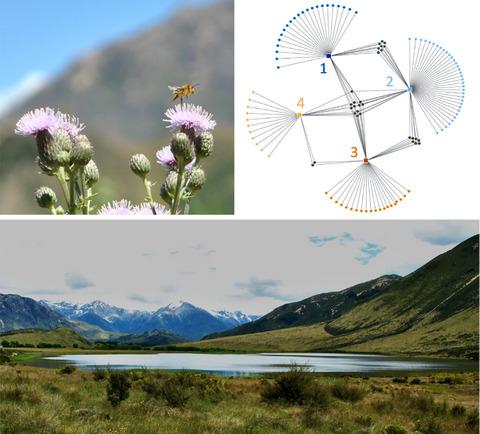Our official English website, www.x-mol.net, welcomes your feedback! (Note: you will need to create a separate account there.)
Alien plants and flower visitors disrupt the seasonal dynamics of mutualistic networks
Journal of Ecology ( IF 5.5 ) Pub Date : 2019-11-26 , DOI: 10.1111/1365-2745.13332 Blanca Arroyo‐Correa 1, 2 , Laura A. Burkle 3 , Carine Emer 4
中文翻译:

外来植物和花卉访客破坏了相互关系网络的季节性动态
更新日期:2019-11-26
Journal of Ecology ( IF 5.5 ) Pub Date : 2019-11-26 , DOI: 10.1111/1365-2745.13332 Blanca Arroyo‐Correa 1, 2 , Laura A. Burkle 3 , Carine Emer 4
Affiliation

|
- Alien species can drastically disrupt ecological processes such as those involving plant–pollinator interactions, performing central roles that may affect the structure of native pollination networks. However, most studies to date have focused on a single trophic level of alien species, evaluating either the impacts of an alien pollinator or an alien plant species, and have neglected their joint effects on the seasonal dynamics of mutualistic networks.
- Here, we aim to fill this gap by investigating how alien plant and flower visitor (here used as a proxy for pollinator) species structure temporal networks, and how these species affect the beta‐diversity of interactions across a flowering season. Our study system is located in the South Island of New Zealand, where 68% of the sampled plant species and 14% of the flower visitor species that interact with them are alien.
- Alien flower visitor species exhibited higher interaction degree, specialization and strength than their native counterparts, while alien plant species showed the opposite pattern. We found that invader complexes (in which alien species interact significantly more with each other than with native species) were established across the season, and interactions involving alien plant species were the main connectors of the temporal networks. Both alien plant and flower visitor species increased total interaction turnover through the flowering season by promoting interaction rewiring in the case of alien plants and by increasing species turnover in the case of alien flower visitors.
- Synthesis . This study provides one of the first empirical reports of alien species shaping the seasonal dynamics of plant–flower visitor networks. We demonstrate that the presence of alien species may simultaneously lead to a homogenization of plant species composition and increase the diversity of plant–flower visitor interactions through a flowering season. Additionally, we highlight the importance of considering the role of different trophic levels when analysing the impact of alien species in plant–flower visitor communities. Overall, our findings suggest that management strategies should pay particular attention to the timescale at which interactions with alien species dissolve or form, and to the consequences and drivers of such seasonal dynamics.
中文翻译:

外来植物和花卉访客破坏了相互关系网络的季节性动态
- 外来物种会极大地破坏生态过程,例如涉及植物与授粉媒介相互作用的生态过程,发挥可能影响本地授粉网络结构的核心作用。但是,迄今为止,大多数研究都集中在单一营养水平的外来物种上,评估了外来授粉媒介或外来植物物种的影响,而忽略了它们对互惠网络季节性动态的共同影响。
- 在这里,我们旨在通过调查外来植物和花卉访客(这里用作授粉媒介)物种的时态网络,以及这些物种如何影响整个开花季节相互作用的β-多样性来填补这一空白。我们的研究系统位于新西兰的南岛,那里有68%的采样植物物种和14%的与其互动的花卉访问者物种是外来物种。
- 外来花种的互动程度,专业性和强度都比外来花种高,而外来花种则相反。我们发现,整个季节都建立了入侵者复合体(其中外来物种之间的相互作用比本地物种显着更多),而涉及外来植物物种的相互作用是时态网络的主要连接者。外来植物和花卉来访者物种通过促进交互重新布线(对于外来植物而言)和通过增加物种更新(对于外来花朵来访者而言)来增加整个开花季节的总交互交易量。
- 综合。这项研究提供了最早的外来物种影响植物-花卉访客网络的季节动态的经验报告之一。我们证明,外来物种的存在可能同时导致植物物种组成的均质化,并在整个开花季节增加植物-花卉访客互动的多样性。此外,我们强调了在分析外来物种对植物-花卉访客群落的影响时,考虑不同营养级别的作用的重要性。总体而言,我们的发现表明,管理策略应特别注意与外来物种相互作用溶解或形成的时间范围,以及此类季节性动态的后果和驱动因素。



























 京公网安备 11010802027423号
京公网安备 11010802027423号